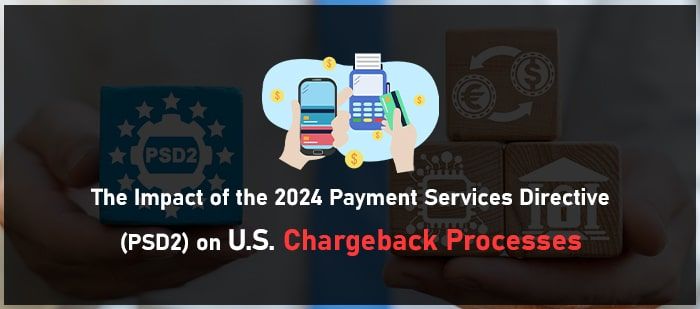
As the 2024 Payment Services Directive (PSD2) unfolds, its implications for chargeback regulations under PSD2 are set to reshape the financial landscape in the U.S. This directive, designed to enhance consumer protection and promote secure online transactions in Europe, is likely to influence how American businesses handle chargebacks.
With an emphasis on increased transparency and more stringent requirements for verifying transactions, U.S. merchants may find themselves adapting their processes to align with these new standards.
This shift not only aims to minimize fraudulent activities but also challenges businesses to refine their chargeback management strategies.
As U.S. financial institutions and payment processors begin to integrate aspects of PSD2, understanding these changes will be crucial for merchants looking to navigate the evolving chargeback environment effectively. The intersection of U.S. payment practices and European regulations could lead to a significant transformation in how chargebacks are approached, impacting everything from customer service to financial accountability.
Understanding PSD2 and Its Global Relevance
The Payment Services Directive 2 (PSD2) is a significant regulatory framework introduced by the European Union to bolster consumer protection, enhance the security of online payments, and foster innovation in the financial sector.
It mandates strong customer authentication (SCA) and open banking practices, requiring financial institutions to share customer data with third-party providers securely, with the customer’s consent. This opens the door for new financial products and services, ultimately increasing competition and providing consumers with more choices.
PSD2’s global relevance cannot be overstated. As the EU sets a high bar for security and transparency, other regions, including the U.S., are observing these developments closely.
The directive’s stringent requirements for transaction verification and fraud prevention serve as a model for other countries grappling with similar issues. U.S. businesses, particularly those engaged in international trade or with a significant online presence, may find themselves indirectly influenced by these standards.
By understanding PSD2, U.S. financial institutions and merchants can better prepare for potential regulatory shifts and align their practices with global trends. This proactive approach will not only ensure compliance but also position American businesses competitively in the global marketplace.
Some Related Blogs
- Understanding Chargeback Rights and Obligations for U.S. Businesses and Consumers
- The Financial Impact of Chargebacks: How U.S. Companies Can Save with Strategic Solutions
- Top Chargeback Management Solutions for U.S. Merchants in 2024
- How Payment Authentication Mitigates Chargeback Risks
How PSD2 Changes Chargeback Regulations
PSD2 brings about notable changes to chargeback regulations by emphasizing enhanced security measures and rigorous transaction verification protocols. One of the key aspects is the implementation of Strong Customer Authentication (SCA), which requires multi-factor authentication for most online transactions.
This reduces the likelihood of fraudulent transactions, consequently decreasing the number of illegitimate chargebacks. Additionally, PSD2’s transparency requirements mean that consumers will receive more detailed transaction information, making it easier for them to identify legitimate charges and reducing disputes based on misunderstandings.
For U.S. merchants, this means a shift toward adopting more robust authentication methods and refining their transaction tracking systems to meet these higher standards. With third-party access to customer data under open banking, merchants may also need to ensure that their data handling practices are up to par with PSD2’s stringent requirements.
This could involve integrating new technologies and protocols to secure customer information and maintain compliance. The enhanced scrutiny on transactions could lead to more accurate chargeback claims and a streamlined resolution process, ultimately benefiting both consumers and merchants by fostering trust and reducing the administrative burden of handling disputes.
The Potential Challenges for U.S. Financial Institutions
The implementation of PSD2 poses several challenges for U.S. financial institutions. One major hurdle is the need to upgrade existing infrastructure to comply with the directive’s stringent security requirements.
This entails significant investment in technology to support Strong Customer Authentication (SCA) and secure data sharing practices mandated by open banking. Additionally, U.S. institutions may face interoperability issues when integrating these new systems with their current platforms, potentially causing operational disruptions.
![]()
Email us anytime!
Email customer service 24/7
![]()
Call us anytime!
Reach customer care 24/7 at +1 (888) 901-8653
Another challenge is the increased regulatory burden. U.S. financial institutions will need to navigate complex compliance landscapes, which may involve additional reporting requirements and audits. Ensuring that all processes meet PSD2 standards will require comprehensive training for staff and possibly the hiring of specialized compliance personnel.
Furthermore, adapting to PSD2 could strain relationships with third-party service providers.
Financial institutions must ensure that these partners also comply with PSD2 regulations, adding another layer of complexity to managing vendor relationships. Lastly, the focus on transparency and detailed transaction information means that U.S.
Institutions must develop more robust mechanisms for data handling and customer communication, ensuring that consumers are well-informed and protected throughout the transaction process. These adjustments, while necessary, could be resource-intensive and time-consuming.


